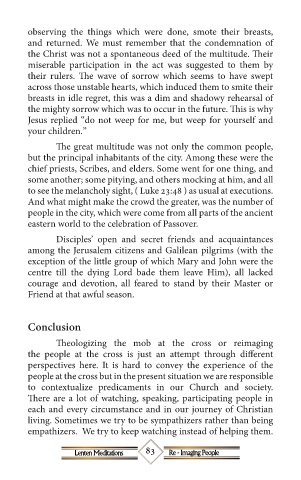Page 89 - laten-08-06-2020
P. 89
observing the things which were done, smote their breasts,
and returned. We must remember that the condemnation of
the Christ was not a spontaneous deed of the multitude. Their
miserable participation in the act was suggested to them by
their rulers. The wave of sorrow which seems to have swept
across those unstable hearts, which induced them to smite their
breasts in idle regret, this was a dim and shadowy rehearsal of
the mighty sorrow which was to occur in the future. This is why
Jesus replied “do not weep for me, but weep for yourself and
your children.”
The great multitude was not only the common people,
but the principal inhabitants of the city. Among these were the
chief priests, Scribes, and elders. Some went for one thing, and
some another; some pitying, and others mocking at him, and all
to see the melancholy sight, ( Luke 23:48 ) as usual at executions.
And what might make the crowd the greater, was the number of
people in the city, which were come from all parts of the ancient
eastern world to the celebration of Passover.
Disciples’ open and secret friends and acquaintances
among the Jerusalem citizens and Galilean pilgrims (with the
exception of the little group of which Mary and John were the
centre till the dying Lord bade them leave Him), all lacked
courage and devotion, all feared to stand by their Master or
Friend at that awful season.
Conclusion
Theologizing the mob at the cross or reimaging
the people at the cross is just an attempt through different
perspectives here. It is hard to convey the experience of the
people at the cross but in the present situation we are responsible
to contextualize predicaments in our Church and society.
There are a lot of watching, speaking, participating people in
each and every circumstance and in our journey of Christian
living. Sometimes we try to be sympathizers rather than being
empathizers. We try to keep watching instead of helping them.
83
Lenten Meditations Re - Imaging People

